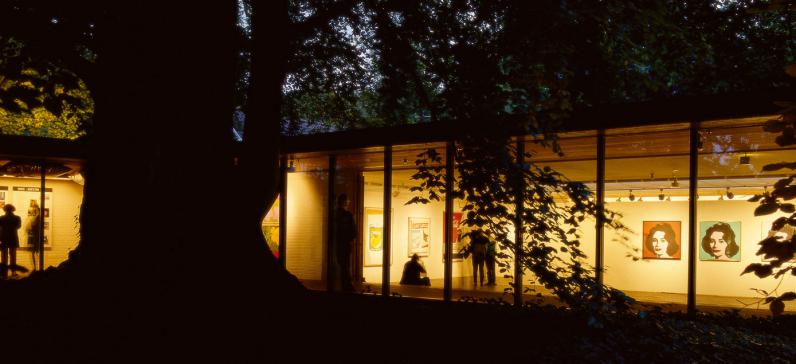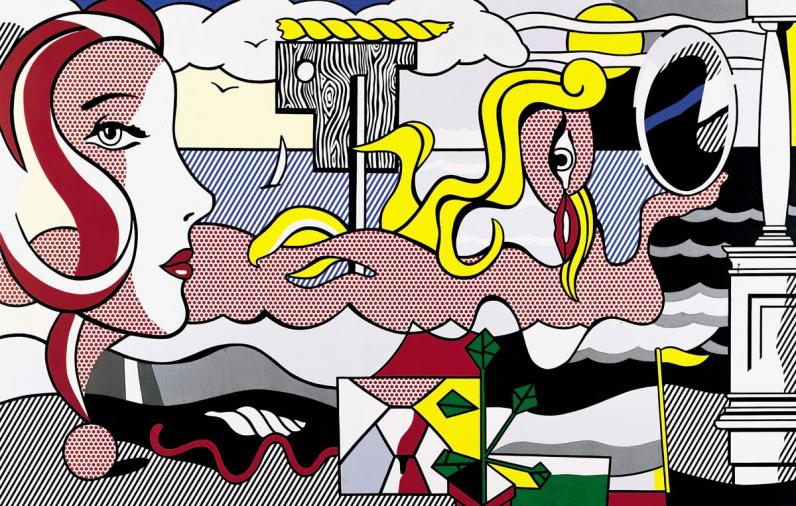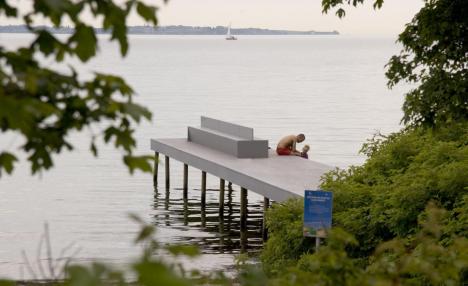
LOUISIANA AS A PLACE
“It’s fine if a visit to Louisiana is a little like a visit to an eccentric uncle who collects art,” said Knud W. Jensen, the museum’s founder. Seen from the outside, Louisiana does not give an impression of being a large museum. On the contrary, it can seem intimate and domestic, and that is precisely the intention. Louisiana was created to be a special place that would stand out in relation to the country’s other art museums.
The beginning of the story
In 1955, Knud W. Jensen bought a one hundred years old white villa named Louisiana. At the time, he was a businessman and cheese wholesaler, but he dreamt of creating a museum for modern Danish art. He was eager to get art out to the people, and in 1955 he co-founded the Art at the Workplace association, which lent artworks to workplaces in order to make art a part of people’s everyday lives. The purpose of the new museum was to share art with others. It was also based on a desire to make a break from the sense of alienation that Jensen thought characterized the large museums of the period, with the National Gallery of Art as the primary Danish example. Instead of monumental buildings, he wanted buildings on a human scale and close to nature. The Louisiana Museum of Modern Art opened three years later, in 1958.
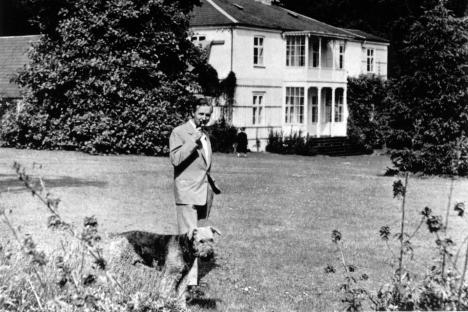 Knud W. Jensen in front of the Old Villa around 1955. Photo: Louisiana Photo Archive
Knud W. Jensen in front of the Old Villa around 1955. Photo: Louisiana Photo Archive
Louisiana was intended to be a lively sanctuary for ordinary people, far from the city. The objective was to create a new way of visiting a museum: Art, architecture and nature would provide the framework, and music, film, dance, poetry readings and political debates would also take place at the museum. And Louisiana had its own café, which was unusual in the 1950s. Critics argued that the café, concerts and other entertainment would remove the focus from art, but Jensen was keen to make Louisiana an excursion venue where the art is part of the experience but not the entire experience. It was possible to create a place that went so much against the tide because an individual with his own resources financed and thus managed the museum. For many years, Jensen’s personal desires and ideas determined Louisiana’s development, even though the museum also had a board of directors. Since 1968, Louisiana has been a state-authorized museum. This means that it receives financial support from the Danish state. It also entails certain obligations, for example it must comply with the Danish Museum Act (see the theme entitled “The Museum as a Place”).
As early as the year after the museum opened, the seeds were sown for a reconsideration of the museum’s work when Jensen visited Documenta. Documenta is a major international exhibition of contemporary art that is held in Kassel, Germany (now every five years – in the beginning, it was held more frequently). Documenta first took place in 1955, and it has always had a great influence in determining what artists and artistic movements are considered important. At Documenta in 1959, Jensen saw works by Henry Moore, Alberto Giacometti and Alexander Calder and got what he described as a “Documenta shock”. It caused him to work in a new direction for Louisiana so that the museum would now focus on contemporary international art. It was big decision because at that time there was no international modern art museum in Denmark. Many, including some on the museum’s own board, considered it too risky to try to measure up to international museums, but Jensen persuaded them and got Louisiana onto the track the museum still follows today.
The spirit of the place (genius loci)
Louisiana Museum was built in several stages and has been expanded many times over the years. But the starting point was a place where something already stood. The villa with a park full of distinctive trees was built for the first owner, Alexander Brun, who was Master of the Royal Hunt. It has been important throughout the museum’s history to maintain the “spirit of the place” (also called “genius loci”) that Knud W. Jensen thought he found there when he discovered the location. Jensen engaged two architects, Jørgen Bo and Vilhelm Wohlert, to build extensions to Louisiana, and together they went around the large grounds for months to find the best places, the most interesting trees and the finest views. They tried to listen to the nature of the place that was Louisiana’s setting. They decided, for example, to let the glass corridor wind around a large old beech tree with nine trunks rather than remove the tree.
 Café scene in the museum’s early years. Photo: Mobilia
Café scene in the museum’s early years. Photo: Mobilia
The idea behind the museum’s architecture was to create a wide-ranging tour through the museum. Because of the varied course, what happens around the next corner is always a surprise. A large space is followed by a low-ceilinged corridor, which in turn leads into a large exhibition room. The plan also included fluid transitions between the inside and outside: You often have a view of the park or the sea from within, and it is never far to a door if you suddenly feel like a break from art and a walk in the park. Louisiana was built in several stages over four decades. Many additions have come since the museum was completed in 1958, including new exhibition rooms in 1966, a concert hall in 1976, the South Wing with space for large works in 1982, an underground wing in 1991, and the Children’s Wing, the last major expansion, in 1994.
The architects were inspired by buildings on both sides of the Pacific Ocean – in Japan and America – and also found inspiration in Nordic functionalist architecture. That Louisiana is regarded by many as a very special place with a special “spirit” is often explained by the interplay of nature, architecture and art in the overall experience. About this, Knud W. Jensen wrote:
“One might ask what commonly determines the spirit of a place. A work of art, a piece of architecture or a landscape alone is not enough. Only when a greater whole is created, when art, edifice and landscape unite and thereby enhance the experience, do we get this almost indefinable sense – this is something special.”
 A view of the Sculpture Park from the Old Villa. Photo: Kim Hansen
A view of the Sculpture Park from the Old Villa. Photo: Kim Hansen
The museum as a second home
That Louisiana has attained the status of a special place in many people’s minds may also have to do with the museum’s beginning as a dream of a sanctuary where guests feel at home. The museum has always had the guest as its main focus. Rather than imposing a duty to look at the artwork and learn from it, the intention from the start was to create a stimulating environment, arouse the curiosity of the museum’s visitors, and let that be the entry to their own experience of art.
“I have not been able to learn much about Alexander Brun, the Master of the Royal Hunt who built Louisiana in 1855, but enough so that I can form a picture of him. He was married three times, and each time he found a girl named Louise, which was perhaps a fashionable name then. It’s a good story, which has also been told many times. It was natural to preserve this lovely name. I could not very well call it Humlebæk Museum of Modern Art or Jensen Museum instead. People would die laughing. So, better to let them smile at the curious and poetic name “Louisiana”, which most people thought had something to do with the state of Louisiana in America.”
Knud W. Jensen, from The Spirit of the Place (Gyldendal, 1994).
 Jazz at Louisiana in 1959 in front of William Scharff’s painting Legend. Photo: Mobilia
Jazz at Louisiana in 1959 in front of William Scharff’s painting Legend. Photo: Mobilia
Photographs from the early years give an impression of a relaxed and festive place where most things were allowed (even dancing and smoking close to the artworks!). From the early days, children – and thus their parents as well – were made to feel welcome at the museum. Although the three floors of the Children’s Wing were not built until 1994, before that there was also a room dedicated to children's practical investigations of art, and the Lake Garden has also been a place that encouraged “free play”. In 1978, as part of the Children are a People exhibition, you could even try an aerial runway at the Lake Garden or drift around the lake on a raft.
The artists and Louisiana
When you read reports from the museum or correspondence between artists and the museum, you get a sense that artists have felt comfortable there. Many artists give the impression that they simply feel at home at the museum, which was indeed the founder’s objective. The collection contains a number of works that were created specifically for the museum, and in some cases, the artist has donated works created for the museum. In addition to the site-specific works that are discussed in detail in the individual cases on this website, other examples include the American artist Sam Francis’s abstract paintings for the Concert Hall, which were created on site in 1979. The American pop artist Roy Lichtenstein, after a visit to Louisiana, painted the large Figures in Landscape in 1977. Many elements in the painting seem to be traces of a story about the place Louisiana: the white veranda, the sea, the knot in Knud W. Jensen’s tie, and three female faces painted in differing styles that could be the three Louises to whom the Old Villa’s first owner, Alexander Brun, was married in turn and who gave the Old Villa its name. Other examples of works created for specific locations at Louisiana include Jim Dine’s paintings for the room beside the “break-room” from 1982, Gerhard Merz’s piece from 1996, and Mario Merz’s work, which consists of an igloo with neon lights and a mural. None of these is on permanent display, but Mario Merz’s mural is permanently on site because it is painted on a wall, although it is covered when it is not displayed in its entirety.
An exhibition by the architect Jean Nouvel also had a direct relation to the special spirit of Louisiana. In 2005 Nouvel created an exhibition in which he both showed his own projects and also addressed Louisiana’s architecture. He did this by writing the Louisiana Manifesto and by creating small interventions at Louisiana: a chair in front of pieces in the exhibition, a pier at the beach, benches to lie on, and so on. He wanted to give visitors the opportunity to see new sides of Louisiana and to have new personal experiences of the place. The Louisiana Manifesto concerns how an architect can learn from Louisiana. In it he praises particularly the coherence between what was built on the site and what the place had been beforehand.
Read excerpts from Jean Nouvel Louisiana Manifesto
Is Louisiana a place for the many or the few?
Louisiana was intended to be a place where everyone would feel welcome. In comparison with other museums, Louisiana was originally seen as a rebellious project that did things in new ways because the focus was on its guests and there was much activity with many changing exhibitions. But after only ten years, in the late 1960s, some young artists called the museum old-fashioned and “bourgeois”, without room for the latest art. As often happens in the arts, the new and different quickly becomes “the normal” for the next generation. Louisiana has already become a concept, and although it was intended to be sanctuary, it is still primarily a museum and exists within the conceptual framework of a museum (see also the theme “The Museum as a Place” for criticism of museums). Today the museum is in many respects a “classical” art museum that exhibits primarily well-established modern art and contemporary art. The main objective is to deliver high-quality content. There is nevertheless still a focus on being a sanctuary and thinking across artistic genres, with a literature festival, concerts, debate evenings and other activities – and not least, on being a place where there is also room for social activity.
Inspiration – the museum as export
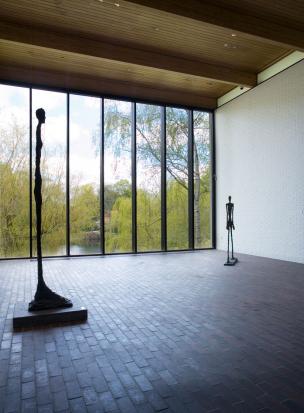 Giacometti Hall overlooking the Lake Garden.
Giacometti Hall overlooking the Lake Garden.
Photo: Lars Ranek
“Briefly put, it [the plan] is that the New Carlsberg Foundation and Louisiana jointly create what could be described as a miniature version of Mittelheim Park in Antwerp: an international collection of sculptures placed in a special, demarcated area at Louisiana.” Knud W. Jensen, in a letter to the New Carlsberg Foundation, 10 February 1961.
Louisiana and especially the Sculpture Park around the museum look the way they do partly because Knud W. Jensen was inspired by other museums and sculpture parks. Today, the reverse is also the case: Other museums are inspired by Louisiana. To be inspired by Louisiana as a site is of course rather ironic, though, since Louisiana is site-specific. It is precisely the place it is because architecture, landscape and art interact, as Jensen expressed it early in its history. Yet there are examples of both houses that were built with Louisiana as a direct model and museums that were more loosely inspired by the linkage between architecture and nature. The Beyeler Foundation in Switzerland, inspired by Louisiana’s Giacometti Hall, constructed a room where their own Giacometti sculptures have a “view” of the surrounding park as Louisiana’s has to the Lake Garden. Also, the Kröller-Müller Museum in the Netherlands, which originally served as inspiration for the Sculpture Park, in a later expansion drew inspiration in turn as it built glass corridors that may remind you of Louisiana’s.
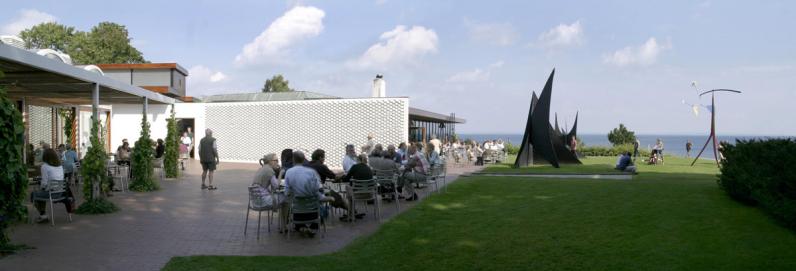 The Calder Terrace in front of the Louisiana Café. Photo: Louisiana Photography Archives
The Calder Terrace in front of the Louisiana Café. Photo: Louisiana Photography Archives
Early on, others were interested in drawing inspiration from Louisiana, as is evident from a statement by Jørgen Sthyr, the chairman of the New Carlsberg Foundation, in 1968: “A few times a year, we read in the newspapers that now some city or municipality wants to have its own Louisiana, and there’s only one reply to that: Even if you can create a building, you cannot create a Knud W. Jensen. The alpha and omega is that the deciding factor is an active person.”
The remark says something to the effect that a physical location, a beautiful building and so on do not in themselves create a “place”. It is the interaction between the physical location and certain people that creates a place, or “the spirit of the place”. It is very much human interaction with places that gives them meaning, both inside and outside the museum (see the themes “The Public Space as Place” and “The Meaning of the Place”). In the case of Louisiana, after Jensen himself retired as director in 1995, the museum continued to pursue the idea of Louisiana as a sanctuary.
ACTIVITIES
“The spirit of the place” concerns the impression of a place – what is special about it. The concept derives from the Latin expression “genius loci”, which was the term for the guardian spirits that the Romans believed protected sites and properties.
Knud W. Jensen, Louisiana’s founder, said and wrote much about the ideas behind the creation of the museum. His thoughts about “the spirit of the place” were crucial in the perception of Louisiana as a special place.
Visit Louisiana’s home page and look at the pages about the museum's history and architecture. Which image does Louisiana wish to give of itself?
Try to capture “the spirit of the place” with you camera. You can only take one photo so take some time to think about where you will take your photo and why. What does your picture say about the place?
Think about another place that you consider to have a special atmosphere or spirit and tell why – either through words, pictures, or sketches. Present your proposal to one another.
Interdisciplinary project, with social studies or history:
Louisiana was founded in 1958. What does the museum’s architecture and the thoughts behind the foundation etc. say about the time where the museum was created? What is the connection between “the spirit of the place” and “the spirit of the time”?
Find more about Denmark in til 1950s at Danmarkshistorien (Århus Universitet) (in Danish) or Golden Days Festival 2012 which focuses on the 1950s (in Danish).











